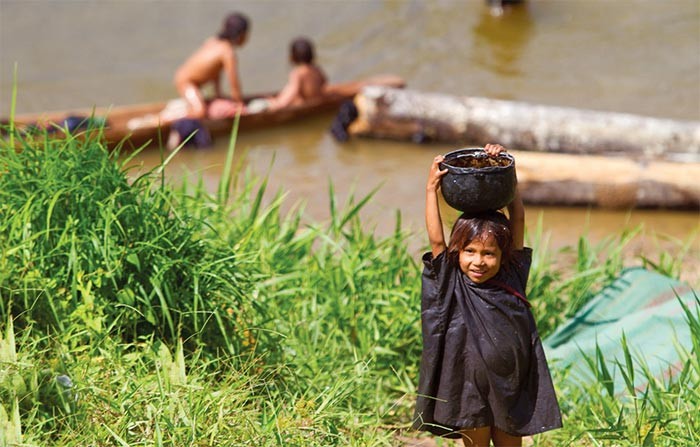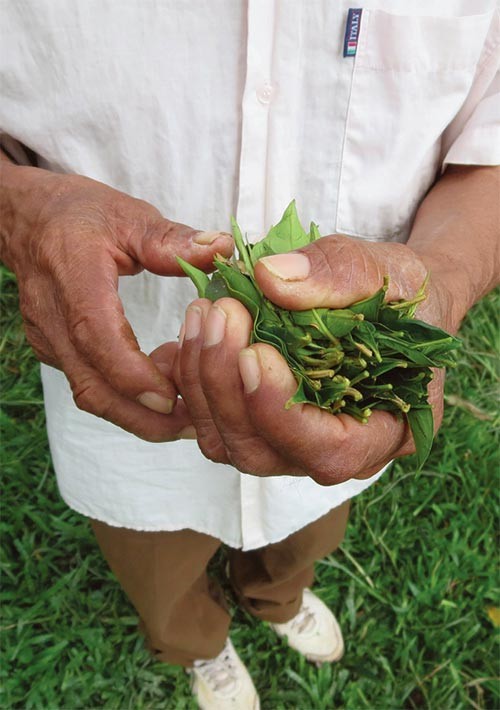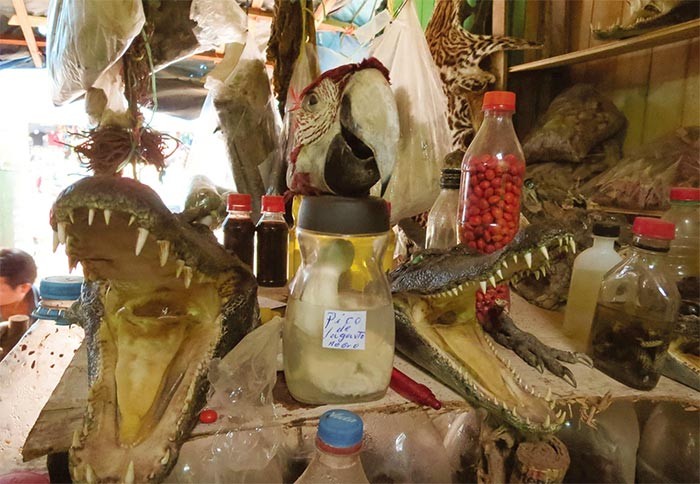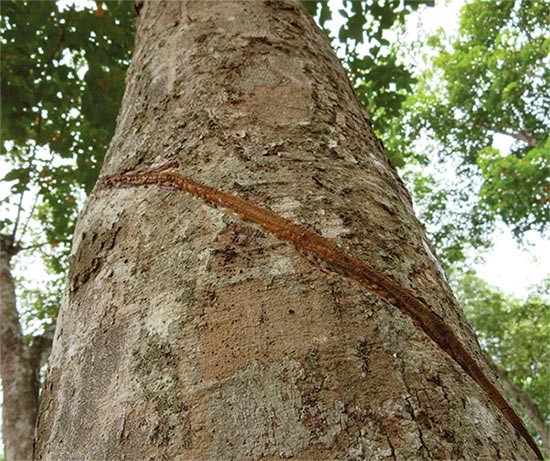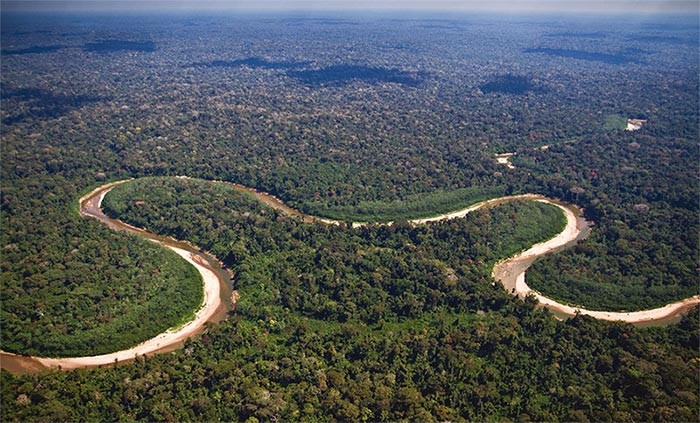
In Peru, a botica is a pharmacy – the sterile, white kind, with glass countertops, bright lights, and shelves lined with tidy boxes.
But I’ve come all the way to Pucallpa – a noisy, frenetic city of 200,000 people along a mud-choked river in the Peruvian Amazon – looking for another kind of pharmacy. Just outside the city’s center, I find it. Among rows of stalls beneath a sprawling blue tarp, vendors hawk the bounty of the Amazon rainforest.
If you believe in this stuff – or if you have no other choice – you can find a cure for all that ails you here. The first stall I visit sells “uña de gato” (“cat’s claw” in English), vine-like twigs wrapped in a bundle like miniature firewood. I approach the vendor, a slight, indigenous man who has been watching me, expressionless. He smiles, as if anticipating my question, and pats his stomach in response. Boiled, it is a cure for gastrointestinal ailments.
On another shelf are recycled one-and two-liter soda bottles filled with inky liquids derived from rainforest plants and animals, and identified by small, handwritten tags taped to their fronts. While I peruse them, a middle-aged Peruvian man in khakis and a button-up shirt arrives and pays two soles (approximately 66 cents) for a shot of sangre de grado (dragon’s blood), a medicinal resin used to fight infections. Other more exotic – and perhaps illegal – products from the forests of Peru also adorn the vendor’s shelves: the toothy dried head of a baby crocodile; a small, live boa in a fish aquarium; a gaudy stuffed macaw; and the outsized paw of a jaguar.
Nearby, booths loom in the dark alleyways like the encroaching limbs of the rainforest, their shelves crammed with a wild and chaotic array of plants and their byproducts – some medicinal, others edible or decorative.
In economic terms, these are non-timber forest products, the tropical equivalent of New England’s fiddleheads, spruce gum, edible mushrooms, and balsam wreaths.
I’d traveled to Peru to assist in a study of non-timber forest products for the Upper Amazon Conservancy, a small but ambitious conservation organization with staff in both the U.S. and Peru. The group’s mission is to help protect the Alto-Purús, Peru’s largest, most remote national park and one of the most biologically and culturally diverse places on the planet.
The park and its surroundings – so wild that tribes still uncontacted by modern civilization wander its rainforest – has increasingly been invaded by rogue loggers, poachers, and drug traffickers. Some of the park’s indigenous villages – thrust into the twenty-first century whether they liked it or not – now seek viable alternative sources of commerce and income.
Options are limited. Valuable tree species like mahogany are harvested, often illegally, but regeneration in the tropics is little understood and hard to control, so the trees rarely grow back as desired. And large-scale, sustainable timber harvesting of the kind we’re familiar with across much of North America is cost-prohibitive: the region is simply too remote. For the same reason, tourism has yet to take hold here.
Chris Fagan, the group’s New England-born director, had asked me to help document the supply and demand of forest products in indigenous villages along a remote stretch of the Purús River, on the outskirts of the park. Selling sustainably harvested forest products in markets like the one I visited in Pucallpa, he hoped, could provide a necessary – albeit modest – boost to local incomes.
Fagan had arranged for me to take a trip along the Purús River to catalogue the supply of such products. From Pucallpa, I flew to Puerto Esperanza, a frontier town of around 4,000 inhabitants accessible only by air from Peru, or by water from Brazil. From there, we boarded a long, slender panga-style boat with a small outboard engine and took off downriver.
Our weeklong trip took us to a dozen villages – often simple clusters of thatched huts in grassy clearings – many of which had been contacted by modern civilization only a few decades before. To me, the thick mantle of riverside rainforest looked wild and unbroken, but our guides occasionally pointed out places where loggers had illegally cut a mahogany or tropical cedar – reminders that competition for resources is keen here.
Each village we visited had a specialty. In San José, not far from Puerto Esperanza, villagers proposed to farm small but tasty local fish, then sell them to wealthier neighbors in Brazil, where incomes and demand are higher. In Santa Rey, elders knew of a prime grove of rubber trees that might produce enough high-quality natural rubber to export for specialty markets. Another village, inhabited by the Asháninka tribe, had found ways to create biofuels from small plots of crops like sugarcane to power their outboard motors and generators.
Many of the cures I’d seen in the market in Pucallpa grew wild and abundant near the villages. One group had proposed to create a medicinal plant garden to ensure that tribal traditions and knowledge were passed on to the region’s youth. Other villages grew cacao, kept bees, wove baskets, and harvested mahogany seeds – all of which have the potential for exportation.
The variety of products and ideas seemed as diverse as the Amazon rainforest itself.
The idea of capitalizing on the Amazon’s forest bounty is not new. In the early twentieth century, rubber barons infamously forced indigenous laborers to tap the region’s shiringa, or rubber trees (Hevea brasiliensis), to make tires for that era’s great technological innovation: the automobile. And some of mankind’s most important medicines originate from South America: quinine, used to treat malaria; novocaine, a numbing agent favored by dentists; and curare, a medicine used to treat Parkinson’s disease.
By the late twentieth century, many scientists and conservationists had begun to argue against harvesting timber in the rainforests because of the many other benefits these forests provide, from carbon storage to natural medicines. The movement had its roots in a 1989 study, published in the academic journal Nature, that tallied all of the seeds, latex, fruits, and medicinal plants on a single hectare of land. Researchers estimated their value at $700, far more than many villagers made in a year and – theoretically – many times higher than the value of the site’s timber potential.
Conservationists celebrated. Here at last was a viable and sustainable solution for those who had long looked for ways to help forest peoples bolster their earnings without chopping down trees. But the study’s dramatic findings led many to some hasty conclusions. Critics pointed out that the researchers had failed to account for variables like transportation costs, spoilage, and the drop in price that would be triggered by increased supply.
More recent studies have shown that the economic usefulness of forest products varies greatly by region and by access to markets. Such concerns are paramount in the Purús, where transportation is slow and unreliable.
My last day on the river served as a cautionary tale. Our return trip to Puerto Esperanza had been delayed by torrential rains and flooding upriver, so we were forced to travel along the river by night. It was slow and dangerous going: we dodged submerged trees as we picked our way through the water, guided by little more than a small plastic flashlight. Twice the motor sputtered and died, leaving us broadside to the current.
At the same time, I was stricken by fever and a wrenching stomachache that in any other circumstances would have required multiple emergency trips to the bushes and a handful of diarrhea medicine. But I quickly ruled out abandoning ship to squat in the Amazon jungle – alone, in a thunderstorm, and in the dark.
To make matters worse, in the morning I was due to board a plane for a turbulent, two-hour flight to Pucallpa aboard a cramped eight-seater with no bathroom.
It was a tense few hours that seemed destined to get worse until Jairo, one of our indigenous guides, brought me to the home of his grand-father, a curandero (medicine man), from a village upriver. The old man – dressed in western clothes – spoke no Spanish, but Jairo explained my predicament to him. The old man nodded understandingly, then disappeared momentarily into the forest behind his home.
He returned with a handful of leaves that looked to me like basil. He placed them in a small bowl with cool water he dipped from a wooden barrel in the corner of his house, then stirred the mix with a stick and waited.
Five minutes later, he handed me the bowl. I was reluctant. The water was murky and hadn’t been boiled. But my stomach grumbled in protest. How much worse could it get?
I drank the concoction. Ten minutes later, the diarrhea and stomach pains had subsided. I boarded the plane cured and convinced that, despite the challenges, non-timber forest products warrant a closer look.


